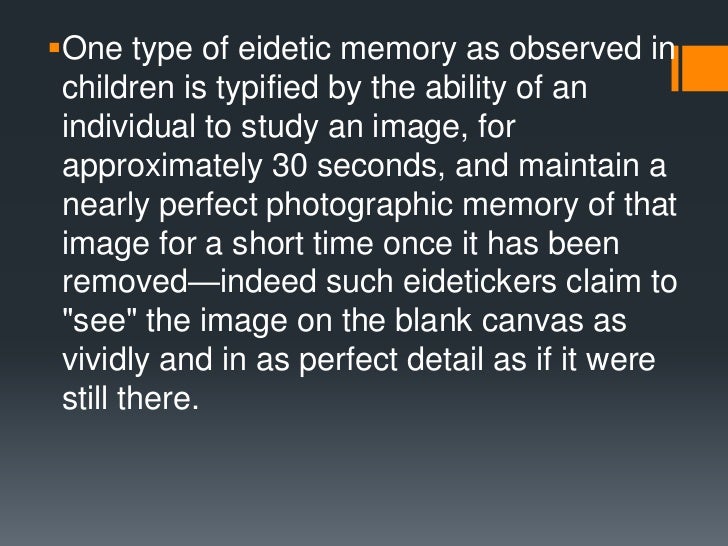
I'm afraid that's going a little overboard. Is it really possible for the layperson to develop an eidetic memory? If you can make out a clear third image, then you have a photographic memory. So do you have an eidetic memory? Test your photographic memory skills now by looking at the two images in this video, and try to mentally superimpose one on top of the other. True eidetickers claim to be able to still see the image on the blank canvas after it has disappeared. In children, the condition is diagnosed by having the child study an image for 30 seconds, then testing their recall.

He could be the Rosetta Stone."Ĭhances are, if you have an eidetic memory (or even a really powerful memory in its own right) you probably already know about it. "Daniel can describe what he sees in his head. It just comes to them," said Professor Allan Snyder of Tammet's condition. "Savants can't usually tell us how they do what they do. What makes Daniel Tammet so special? Aside from his remarkable genius, he has unusually complex synaesthesia, opening doors for scientists looking to study the mind of a savant. A British writer with high-functioning autism and savant syndrome, Daniel is able to calculate complex sums in his head, recite Pi to 22,500 decimal places, and learn Icelandic (one of the world's most difficult languages) in just one week. However, in the following video, Daniel Tammet demonstrates a stunning application of what must be an eidetic memory. However in most cases this is not considered a photographic memory, but rather an impressive memory and attention to detail in their own right. This separates it from any other kind of memory feat - because in all non-eidetickers the data must still be identified and attached with meaning to be recalled.ĭo autistic people have an eidetic memory? Everyone knows that certain people in the autistic spectrum (particularly those with Asperger syndrome) can display amazing mental processes. Indeed, recent studies suggest that true eidetickers possess a lot of raw, unprocessed information. The American cognitive scientist, Marvin Minsky, believes eidetic memory doesn't even exist at all - while others say it exists, but only in a miniscule percentage of the population. They may also instinctively use natural mnemonic devices to aid their learning and recall which, to the casual observer, appears positively magical.

In many cases, so-called eidetickers are just really good at learning, concentration, and connecting seemingly unconnected information - perhaps through the cognitive cross-wiring phenomenon of synaesthesia.

Myth #2 - Just because someone has a very impressive memory, it doesn't mean they have an eidetic memory. However since the stimulus is not literally there, and depending on all those observational factors, it can't really be said to be a literal photographic impression. The technical definition of an eidetic memory is to have such a vivid impression of an event that the eideticker can still see the scene in their mind's eye after it has disappeared from view. In truth, an eidetic memory is subject to the same factors as regular memory: how long they looked at the stimulus, how many repeat exposures they had, and whether they gave it much conscious attention. It implies that, once captured, the memory remains perfectly intact and can't possibly be faulted because it is so immaculately ingrained in the first place. Myth #1 - The term photographic memory is a misnomer. There are two conflicting myths about having an eidetic memory which throws the concept into controversy. The term comes from the Greek word eidos which means "seen" and refers to the extraordinarily vivid recall of visual scenes.īut is such a phenomenon real? And can anyone develop a photographic memory? An eidetic memory (or photographic memory) is the ability to remember vivid images and sounds with astonishing precision.


 0 kommentar(er)
0 kommentar(er)
